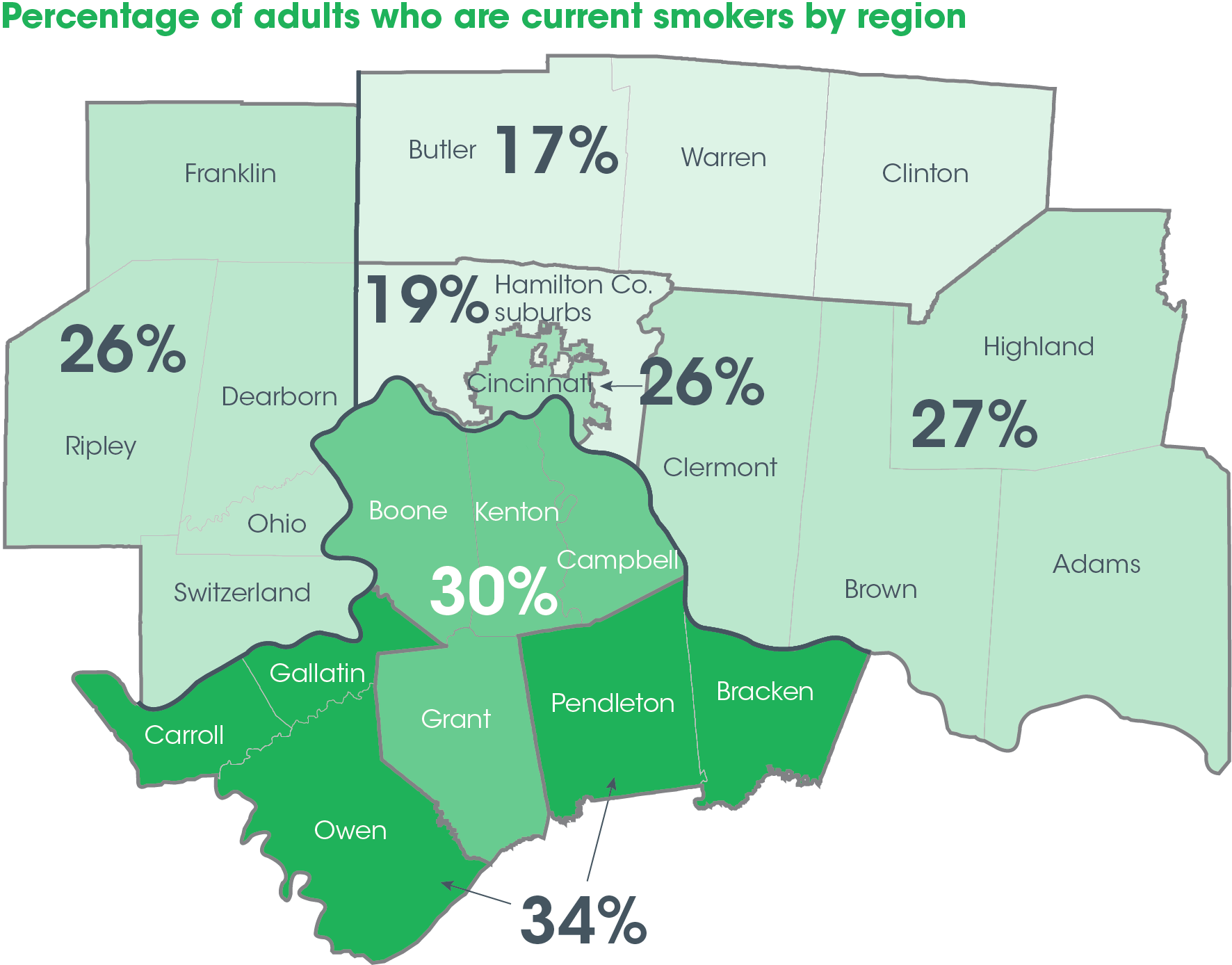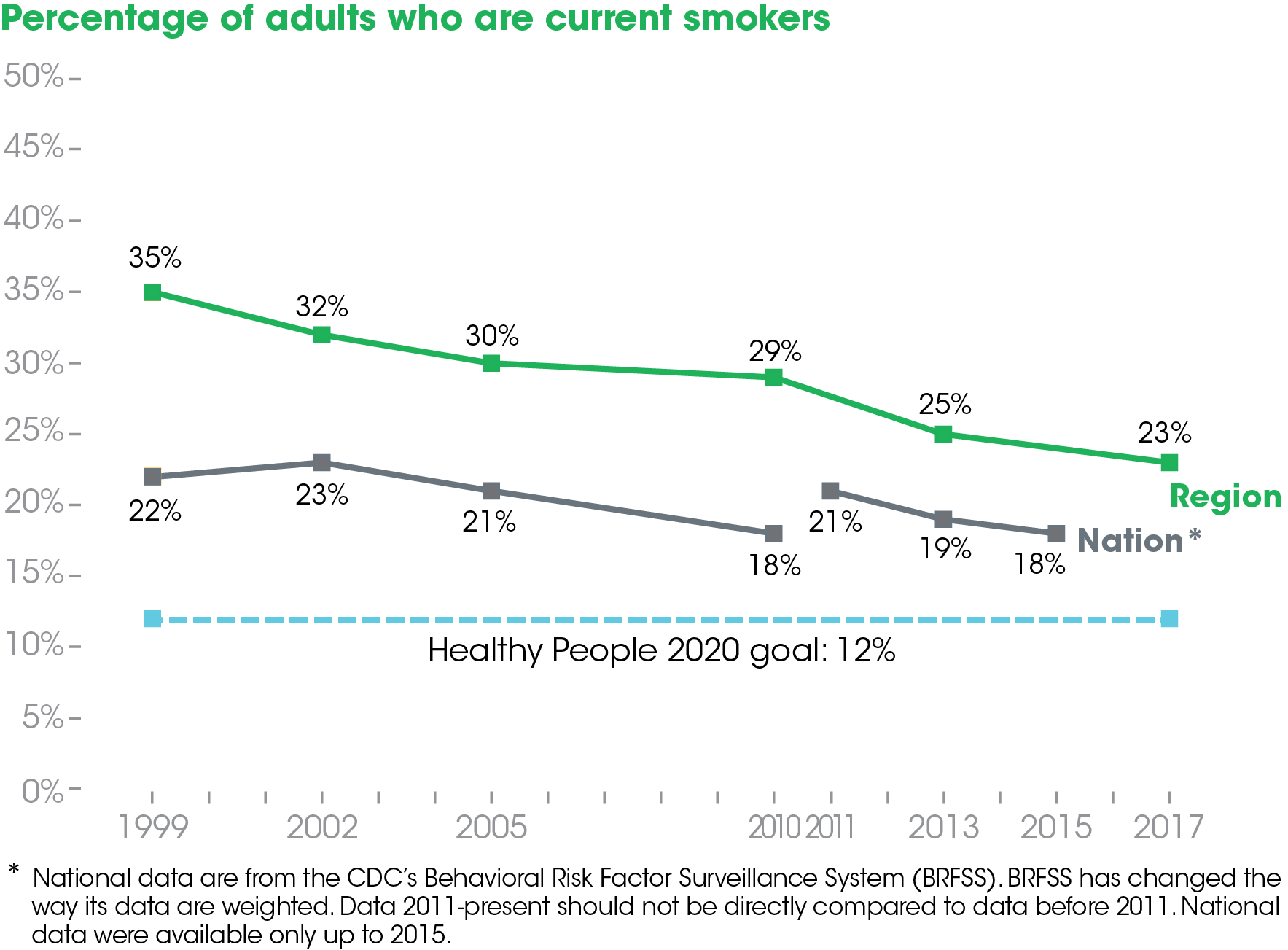The 2017 Community Health Status Survey (CHSS), funded by Interact for Health, has found that 23 percent of adults in our region are current smokers.
This percentage has been steadily declining since the question was first asked in 1999. However, the percentage of adults in Greater Cincinnati and Northern Kentucky who are current smokers continues to be higher than the nation.
Boone, Campbell, Grant and Kenton counties in Northern Kentucky reported higher percentages than the region, with 30 percent reporting being current smokers (versus 23 percent across the region). This is similar to the rate of 25 percent reported in 2013.
Bracken, Carroll, Gallatin, Owen and Pendleton counties also reported higher rates than the region, with 34 percent reporting being current smokers (versus 23 percent across the region). This is similar to 2013 when the rate was 33 percent.

According to the Centers for Disease Control and Prevention’s Behavioral Risk Factor Surveillance System (BRFSS), 18 percent of adults in the United States were smokers in 2015. This percentage is higher than the Healthy People 2020 goal of 12 percent.
“Smokers are at a greater risk for many health problems such as cancer, heart disease and stroke,” says O’dell M. Owens, M.D., M.P.H., President/CEO of Interact for Health. “One thing that would improve health the most in our region would be to reduce our tobacco use. Smokers who quit can add as much as 10 years to their lives.”

Dr. O’dell Owens
Nearly half of adults earning 100% or less of the Federal Poverty Guidelines (FPG) reported that they are current smokers (46 percent). This compares with 3 in 10 adults (33 percent) earning between 100% and 200% FPG, and fewer than 2 in 10 adults (15 percent) earning more than 200% FPG. The percentage of adults earning more than 200% FPG who smoke has declined by half over the past 15 years. However, the percentage of adults in other income groups who are smokers has remained about the same.
Smoking also varies by education. Adults with less education are more likely to be smokers. About 1 in 10 college graduates reported being current smokers (10 percent). That compares with 2 in 10 adults with some college (21 percent), 3 in 10 high school graduates (31 percent) and 4 in 10 adults with less than a high school diploma (40 percent). The percentage of adults with less than a high school education who smoke declined since 2013 (54 percent). All other groups remained about the same.
The percentage of adults reporting that they are current smokers varies by region. At least 3 in 10 adults in rural Kentucky counties (34 percent) and urban Kentucky counties (30 percent) reported being current smokers. Almost 3 in 10 adults in rural Ohio counties (27 percent), Indiana counties (26 percent) and the city of Cincinnati (26 percent) reported being current smokers. Fewer than 2 in 10 adults in Hamilton County suburbs (19 percent) and suburban Ohio counties (17 percent) reported being current smokers.
Two in 10 adults allow people to smoke in the home
CHSS also asked, “Do you allow people to smoke in your home?”
Explains Dr. Owens, “Secondhand smoke can cause significant health problems for nonsmokers, including ear infections, asthma attacks, respiratory infections, heart disease and lung cancer.”
Nearly 2 in 10 adults in our region reported that they allow people to smoke in their home (18 percent). In Northern Kentucky, Boone, Campbell, Grant and Kenton county adults were similar to the region, with 21 percent saying that they allowed smoking in their homes.

In Bracken/Carroll/Gallatin/Owen/Pendleton Counties, 35 percent said they allowed smoking in their homes – the highest rate in the region.
Current smokers (48 percent) are much more likely to allow this than previous smokers (12 percent) and adults who have never smoked (9 percent).
As with the smoking question, responses to this question vary by income. Four in 10 adults earning less than 100% FPG reported allowing people to smoke in their home. That compares with more than 2 in 10 adults earning between 100% and 200% FPG (25 percent) and 1 in 10 adults earning more than 200% FPG (10 percent).
More information about Greater Cincinnati adults’ smoking habits, and other topics, is available online
The 2017 Community Health Status Survey (CHSS) was conducted by the Institute for Policy Research at the University of Cincinnati for Interact for Health. A total of 4,261 randomly selected adults residing in eight Ohio counties, nine Kentucky counties, and five Indiana counties were interviewed by telephone between August 10, 2016, and March 8, 2017. This included 1,906 landline interviews and 2,355 cell phone interviews. The potential sampling error for the overall survey data is ±1.5%. For more information about the CHSS and a list of community partners, please visit www.interactforhealth.org/community-health-status-survey.
Interact for Health is building healthy communities for all people, serving as a catalyst for health and wellness by promoting healthy living through grants, education, research, policy and engagement. Interact for Health is an independent foundation that serves 20 counties in Ohio, Kentucky and Indiana.
















